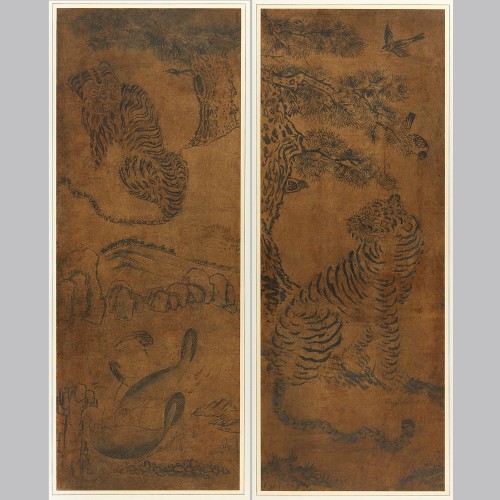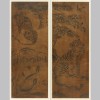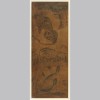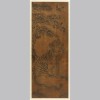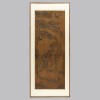본문
조선시대에 그려진 호작도(虎鵲圖) 두 점입니다. 호랑이와 까치를 한 화면에 담아 벽사와 길상의 의미를 표현함과 동시에, 권위의 대상을 풍자적으로 풀어냅니다.
호랑이의 털과 줄무늬는 세밀하게 표현되어 형상의 입체감이 돋보입니다. 호랑이의 놀란 듯한 표정은 공포의 대상을 해학적으로 풀어낸 방식으로도 해석됩니다. 또한, 소나무 위에서 호랑이를 향해 울부짖는 까치의 모습은 단순한 길조를 넘어 권위를 풍자하는 것으로도 볼 수 있습니다.
괴석과 물고기, 새우, 토끼 등은 다산과 풍요, 생명력을 상징하며 화면의 구성을 한층 풍부하게 합니다.
사실적인 묘사와 힘 있는 선, 먹의 농담 표현은 관찰에 기반한 화가의 숙련된 필력을 보여줍니다.
━━━━━
这两幅朝鲜时代的《虎鹊图》,在同一画面中描绘了老虎与喜鹊,既寓意驱邪纳福,又带有对权威的讽刺意味。
老虎的皮毛与条纹描绘细腻,增强了形象的立体感;其惊讶的神情,也可理解为以诙谐方式面对恐惧。高高站在松树上、朝老虎鸣叫的喜鹊,不仅象征吉兆,更有讽刺权威的隐喻。
画中还描绘了怪石、鱼、虾、兔子等元素,象征多子、多福与生命力,使画面更为丰富生动。
写实的描绘手法、富有力量的线条,以及水墨浓淡的运用,展现了画家基于细致观察而来的精湛技艺。
━━━━━
These are two Tiger and Magpie (虎鵲圖) paintings from the Joseon dynasty. By depicting a tiger and a magpie on the same canvas, the artworks express both the themes of warding off evil and invoking good fortune, while also offering a satirical take on figures of authority.
The tiger’s fur and stripes are rendered with meticulous brushwork, giving the figure a sense of three-dimensionality. The startled expression on the tiger’s face can be interpreted as a humorous reinterpretation of a traditionally fearsome figure. Meanwhile, the magpie, shown crying out toward the tiger from atop a pine tree, adds not only auspicious symbolism but also a satirical commentary on power.
Additional elements such as fantastical rocks, fish, shrimp, and rabbits symbolize fertility, abundance, and vitality, enriching the overall composition.
The realistic depiction, bold lines, and subtle gradation of ink tones demonstrate the painter’s skilled brush technique grounded in keen observation.
